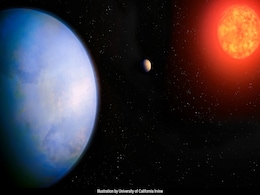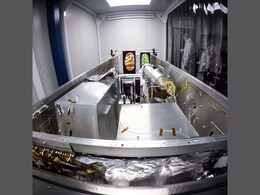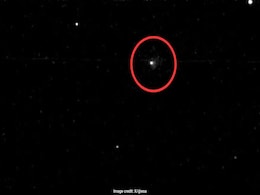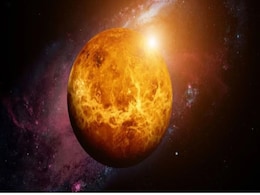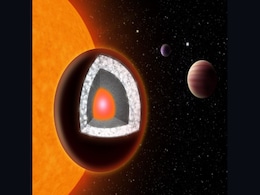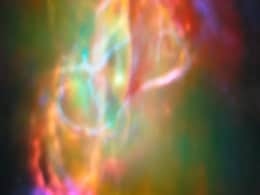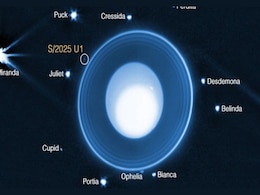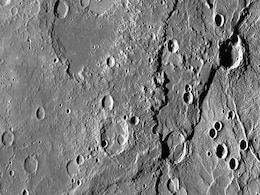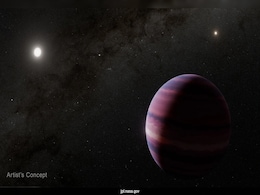New Planets
- All
- News
- Videos
-

Scientists Stunned as Earth’s Magnetosphere Shows Reversed Electric Charge Patterns
- Sunday November 2, 2025
- Written by Gadgets 360 Staff
Scientists have discovered that Earth’s morning-side magnetosphere is negatively charged, overturning decades of assumptions about space electricity. Satellite data and simulations show the charge pattern flips near the equator but remains traditional at the poles. The breakthrough reshapes understanding of space weather and may also clarify elec...
-
 www.gadgets360.com
www.gadgets360.com
-

Strange 'Death Ball' Sponge Among New Species Discovered In Remote Parts Of Planet
- Thursday October 30, 2025
- Feature | Edited by Srishti Singh Sisodia
A carnivorous death-ball sponge with a hooked surface trapping prey was among the unique species found.
-
 www.ndtv.com
www.ndtv.com
-

Possible 'Super-Earth' Discovered Just 20 Light-Years Away, Say Scientists
- Saturday October 25, 2025
- Science | Edited by Nikhil Pandey
The rocky exoplanet is nearly four times Earth's mass and may offer new insights in the search for habitable worlds.
-
 www.ndtv.com
www.ndtv.com
-

Newly Found ‘Super-Earth’ GJ 251 c Could Be One of the Most Promising Worlds for Alien Life
- Sunday October 26, 2025
- Written by Gadgets 360 Staff
A new super-Earth, GJ 251 c, has been found orbiting a nearby red dwarf star within its habitable zone. About four times Earth’s mass, it may host liquid water. Detected via the radial-velocity method using Penn State’s Habitable Zone Planet Finder, it’s a prime target in the search for life.
-
 www.gadgets360.com
www.gadgets360.com
-

One Of The World's Rarest Whales Grows In Population In The Atlantic
- Tuesday October 21, 2025
- World News | Associated Press
One of the rarest whales on the planet has continued an encouraging trend of population growth in the wake of new efforts to protect the giant animals, according to scientists who study them.
-
 www.ndtv.com
www.ndtv.com
-

Ryugu Samples Reveal Ancient Water Flow on Asteroid for a Billion Years
- Saturday October 18, 2025
- Written by Gadgets 360 Staff
Microscopic samples from asteroid Ryugu reveal that liquid water once flowed through its parent body long after its formation. The finding, led by University of Tokyo scientists, suggests that such asteroids may have delivered far more water to early Earth than previously thought, offering a new perspective on how our planet’s oceans originated.
-
 www.gadgets360.com
www.gadgets360.com
-

Astronomers Detect Hints Of Hidden Earth-Sized Planet Beyond Neptune
- Wednesday October 15, 2025
- Written by Gadgets 360 Staff
Astronomers propose the existence of ‘Planet Y’, a hidden Earth-size planet that may orbit closer than the theorized ‘Planet Nine’. Based on Kuiper Belt object patterns, the study suggests a rocky world influencing orbital tilts. Experts remain divided, but upcoming sky surveys could soon confirm or rule out its existence.
-
 www.gadgets360.com
www.gadgets360.com
-

Mars Orbiters Take Rare Images of Interstellar Comet 3I/ATLAS Zooming Past Red Planet
- Wednesday October 8, 2025
- Science | Edited by Srishti Singh Sisodia
ExoMars TGO captured a series of images with its Colour and Stereo Surface Imaging System (CaSSIS).
-
 www.ndtv.com
www.ndtv.com
-

Scientists May Finally Explain Mysterious Crown-Like Features on Venus
- Tuesday September 30, 2025
- Written by Gadgets 360 Staff
Venus’ distinctive crown-like coronae may be explained by heat trapped beneath a rigid mantle layer, according to recent studies. This discovery provides key insights into the planet’s geological activity and helps researchers compare Venus’ surface evolution to that of other planets in our solar system
-
 www.gadgets360.com
www.gadgets360.com
-

New 'Quasi-Moon' Discovered in Earth Orbit May Have Been Hiding There for Decades
- Sunday September 14, 2025
- Written by Gadgets 360 Staff
Astronomers have identified asteroid 2025 PN7 as a possible quasi-moon of Earth, trailing our planet for nearly 70 years. At just 62 feet wide, it is the smallest and least stable quasi-satellite detected so far. Researchers believe advanced observatories like the Vera Rubin Observatory could uncover more hidden companions in Earth-like orbits
-
 www.gadgets360.com
www.gadgets360.com
-

Diamond 'Super-Earth' May Not Be Quite as Precious as Once Thought, Study Finds
- Monday September 8, 2025
- Written by Gadgets 360 Staff
New research challenges the idea that 55 Cancri e, once dubbed a “diamond planet”, is rich in carbon. Re-analysing telescope data, scientists concluded that the host star has a lot more oxygen than originally believed, making the possibility that its planet formed with a carbon-dominant atmosphere less likely.
-
 www.gadgets360.com
www.gadgets360.com
-

James Webb Space Telescope Spots Planet-Building Dust in the Butterfly Nebula
- Friday August 29, 2025
- Written by Gadgets 360 Staff
The James Webb Space Telescope has unveiled stunning new details of the Butterfly Nebula, a planetary nebula 3,400 light-years away. Using its infrared vision, Webb detected crystalline silicates, large dust grains, and carbon-rich PAH molecules within the nebula’s dusty torus. These discoveries reveal how dying stars recycle minerals and organic...
-
 www.gadgets360.com
www.gadgets360.com
-

James Webb Telescope Discovers Tiny New Moon Orbiting Uranus
- Saturday August 23, 2025
- Written by Gadgets 360 Staff
A team from the Southwest Research Institute has discovered a tiny new moon orbiting Uranus using NASA’s James Webb Space Telescope. The moon, called S/2025 U1, is just 6 miles (10 kilometers) wide, too small for Voyager 2 to detect during its 1986 flyby. This discovery brings Uranus’s total known moons to 29, with S/2025 U1 orbiting 35,000 mil...
-
 www.gadgets360.com
www.gadgets360.com
-

Mercury Has Shrunk by Several Kilometers Over Billions of Years, Scientists Report
- Tuesday August 19, 2025
- Written by Gadgets 360 Staff
Mercury’s surface reveals it has been shrinking for billions of years due to cooling and faulting. A new study estimates the planet’s radius has contracted by 2.7–5.6 kilometers, offering the most precise figures yet. The findings sharpen understanding of Mercury’s thermal evolution and could help scientists apply the same techniques to tec...
-
 www.gadgets360.com
www.gadgets360.com
-

A New 'Earth' Next Door? Scientists Detect Possible Habitable Planet Around Closest Sun-Like Star
- Friday August 15, 2025
- Science | Edited by Nikhil Pandey
Astronomers using JWST have detected a giant exoplanet in the habitable zone of Alpha Centauri A, our nearest Sun-like star.
-
 www.ndtv.com
www.ndtv.com
-

Scientists Stunned as Earth’s Magnetosphere Shows Reversed Electric Charge Patterns
- Sunday November 2, 2025
- Written by Gadgets 360 Staff
Scientists have discovered that Earth’s morning-side magnetosphere is negatively charged, overturning decades of assumptions about space electricity. Satellite data and simulations show the charge pattern flips near the equator but remains traditional at the poles. The breakthrough reshapes understanding of space weather and may also clarify elec...
-
 www.gadgets360.com
www.gadgets360.com
-

Strange 'Death Ball' Sponge Among New Species Discovered In Remote Parts Of Planet
- Thursday October 30, 2025
- Feature | Edited by Srishti Singh Sisodia
A carnivorous death-ball sponge with a hooked surface trapping prey was among the unique species found.
-
 www.ndtv.com
www.ndtv.com
-

Possible 'Super-Earth' Discovered Just 20 Light-Years Away, Say Scientists
- Saturday October 25, 2025
- Science | Edited by Nikhil Pandey
The rocky exoplanet is nearly four times Earth's mass and may offer new insights in the search for habitable worlds.
-
 www.ndtv.com
www.ndtv.com
-

Newly Found ‘Super-Earth’ GJ 251 c Could Be One of the Most Promising Worlds for Alien Life
- Sunday October 26, 2025
- Written by Gadgets 360 Staff
A new super-Earth, GJ 251 c, has been found orbiting a nearby red dwarf star within its habitable zone. About four times Earth’s mass, it may host liquid water. Detected via the radial-velocity method using Penn State’s Habitable Zone Planet Finder, it’s a prime target in the search for life.
-
 www.gadgets360.com
www.gadgets360.com
-

One Of The World's Rarest Whales Grows In Population In The Atlantic
- Tuesday October 21, 2025
- World News | Associated Press
One of the rarest whales on the planet has continued an encouraging trend of population growth in the wake of new efforts to protect the giant animals, according to scientists who study them.
-
 www.ndtv.com
www.ndtv.com
-

Ryugu Samples Reveal Ancient Water Flow on Asteroid for a Billion Years
- Saturday October 18, 2025
- Written by Gadgets 360 Staff
Microscopic samples from asteroid Ryugu reveal that liquid water once flowed through its parent body long after its formation. The finding, led by University of Tokyo scientists, suggests that such asteroids may have delivered far more water to early Earth than previously thought, offering a new perspective on how our planet’s oceans originated.
-
 www.gadgets360.com
www.gadgets360.com
-

Astronomers Detect Hints Of Hidden Earth-Sized Planet Beyond Neptune
- Wednesday October 15, 2025
- Written by Gadgets 360 Staff
Astronomers propose the existence of ‘Planet Y’, a hidden Earth-size planet that may orbit closer than the theorized ‘Planet Nine’. Based on Kuiper Belt object patterns, the study suggests a rocky world influencing orbital tilts. Experts remain divided, but upcoming sky surveys could soon confirm or rule out its existence.
-
 www.gadgets360.com
www.gadgets360.com
-

Mars Orbiters Take Rare Images of Interstellar Comet 3I/ATLAS Zooming Past Red Planet
- Wednesday October 8, 2025
- Science | Edited by Srishti Singh Sisodia
ExoMars TGO captured a series of images with its Colour and Stereo Surface Imaging System (CaSSIS).
-
 www.ndtv.com
www.ndtv.com
-

Scientists May Finally Explain Mysterious Crown-Like Features on Venus
- Tuesday September 30, 2025
- Written by Gadgets 360 Staff
Venus’ distinctive crown-like coronae may be explained by heat trapped beneath a rigid mantle layer, according to recent studies. This discovery provides key insights into the planet’s geological activity and helps researchers compare Venus’ surface evolution to that of other planets in our solar system
-
 www.gadgets360.com
www.gadgets360.com
-

New 'Quasi-Moon' Discovered in Earth Orbit May Have Been Hiding There for Decades
- Sunday September 14, 2025
- Written by Gadgets 360 Staff
Astronomers have identified asteroid 2025 PN7 as a possible quasi-moon of Earth, trailing our planet for nearly 70 years. At just 62 feet wide, it is the smallest and least stable quasi-satellite detected so far. Researchers believe advanced observatories like the Vera Rubin Observatory could uncover more hidden companions in Earth-like orbits
-
 www.gadgets360.com
www.gadgets360.com
-

Diamond 'Super-Earth' May Not Be Quite as Precious as Once Thought, Study Finds
- Monday September 8, 2025
- Written by Gadgets 360 Staff
New research challenges the idea that 55 Cancri e, once dubbed a “diamond planet”, is rich in carbon. Re-analysing telescope data, scientists concluded that the host star has a lot more oxygen than originally believed, making the possibility that its planet formed with a carbon-dominant atmosphere less likely.
-
 www.gadgets360.com
www.gadgets360.com
-

James Webb Space Telescope Spots Planet-Building Dust in the Butterfly Nebula
- Friday August 29, 2025
- Written by Gadgets 360 Staff
The James Webb Space Telescope has unveiled stunning new details of the Butterfly Nebula, a planetary nebula 3,400 light-years away. Using its infrared vision, Webb detected crystalline silicates, large dust grains, and carbon-rich PAH molecules within the nebula’s dusty torus. These discoveries reveal how dying stars recycle minerals and organic...
-
 www.gadgets360.com
www.gadgets360.com
-

James Webb Telescope Discovers Tiny New Moon Orbiting Uranus
- Saturday August 23, 2025
- Written by Gadgets 360 Staff
A team from the Southwest Research Institute has discovered a tiny new moon orbiting Uranus using NASA’s James Webb Space Telescope. The moon, called S/2025 U1, is just 6 miles (10 kilometers) wide, too small for Voyager 2 to detect during its 1986 flyby. This discovery brings Uranus’s total known moons to 29, with S/2025 U1 orbiting 35,000 mil...
-
 www.gadgets360.com
www.gadgets360.com
-

Mercury Has Shrunk by Several Kilometers Over Billions of Years, Scientists Report
- Tuesday August 19, 2025
- Written by Gadgets 360 Staff
Mercury’s surface reveals it has been shrinking for billions of years due to cooling and faulting. A new study estimates the planet’s radius has contracted by 2.7–5.6 kilometers, offering the most precise figures yet. The findings sharpen understanding of Mercury’s thermal evolution and could help scientists apply the same techniques to tec...
-
 www.gadgets360.com
www.gadgets360.com
-

A New 'Earth' Next Door? Scientists Detect Possible Habitable Planet Around Closest Sun-Like Star
- Friday August 15, 2025
- Science | Edited by Nikhil Pandey
Astronomers using JWST have detected a giant exoplanet in the habitable zone of Alpha Centauri A, our nearest Sun-like star.
-
 www.ndtv.com
www.ndtv.com



